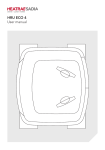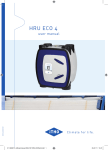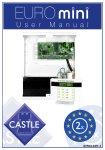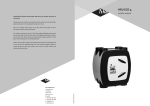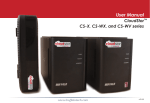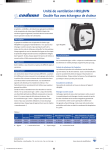Download HRU ECO 3 RF – Heat Recovery Unit
Transcript
APPENDIX Q ELIGIBLE HRU ECO 3 RF – Heat Recovery Unit Technical Brochure Application The Combiflow ventilation system with heat recovery unit HRU ECO 3 RF fan can be applied in different types of newly built houses. Description The heat recovery unit HRU ECO 3 RF is a high efficiency heat recovery unit. It is provided with a sophisticated counter-flow heat exchanger by which the unit uses approximately 95% of the heat of the air that is blown out, to heat up the fresh air from outside. Each unit, as standard, has a bypass valve and a unique mechanism to prevent the unit from freezing. Both mechanisms are fully integrated in the unit. In addition to this, all units are delivered with energy saving DC motors. Characteristics Weight As a result of the unique clamping construction in combination with the plastic/synthetic elements, the weight of the heat recovery unit HRU ECO 3 RF fan is only 25 kg. Programme In table 1 you will find an overview of the heat recovery unit HRU ECO 3 RF. Exhaust and Suction Joints All exhaust and supply air connections have an internal diameter of 150 mm and external 180 mm. The connections can be used to attach Vortice modular ducting and insulated flexible aluminium ducts and accessories. Each connection is provided with an illustration that shows the direction and source of the air. Housing The connections for the ducts routed into the house are situated at the lower part of the unit. The motor module seals the opposite connection. The connections on the upper part of the unit are used for air extract. As standard, two connections are sealed with a cap. Counter Flow Heat Exchanger Due to the unique patented clamp construction of the HRU ECO 3 RF fan, the sealing of the various components will be optimised. Therefore, there will be no internal or external leakage. The unit can easily be turned around in case of a house that is ‘mirrored’. The unique heat exchanger is based on the principle of counter flow. One of the characteristics of this heat exchanger is that the incoming and outgoing air is moving via triangle canals. Because of this each canal is surrounded by canals in which the current is opposite. This creates an enormous surface to exchange heat. This special construction is one of the reasons why an average of 95% temperature efficiency can be reached. Table 1 Type HRU ECO 3 RF Appliance Connections to the House Exhaust Inlet Connections to the Outside Exhaust Inlet I Family House Lower Side Upper Side Lower Side ~ 1 ~ Upper Side Inlet and Exhaust Capacity Standard Max Pressure 225m³h 325m³h 150Pa Bypass Valve The heat recovery unit, as standard, is provided with a bypass valve, which is completely integrated in the unit. The bypass valve ensures that the air supply is diverted completely around the heat exchanger. This means the exhaust air from the dwelling does not heat this fresh air. Especially during summer nights, this bypass valve is useful because the temperature outdoors is often lower than the temperature indoors. The next steps are taken when the frost protection device is started: • The valve is opened (modulating) and intakes some air from the area in which the product is mounted. The air is mixed with the fresh air. • At the same time the supply fan will increase speed to keep the fresh air volume at the same level. The fully automatic temperature controller ensures that the bypass valve is open when: • The inside temperature is higher than needed (not adjustable). • The inside temperature is higher than the outside temperature. • The outside temperature is at or above 19° C for a long period of time (period depends on the exact temperature). When the temperature drops, the supply fan will decrease fan speed, varying until a minimum is reached. • While the temperature is still decreasing, the exhaust fan will speed up as the supply fan slows down. • With extreme low temperatures the supply fan is turned off, the frost protection valve will be closed, but the exhaust fan will keep on running. • After approximately 11/2 hours, the air supply fan will start at a minimum speed and the frost protection valve will be opened to check whether the danger of freezing is gone. When the temperature rises, all above mentioned steps will be carried out in the reverse order. • Both the inside and the outside temperature are measured inside the HRU ECO 3 RF. Therefore, two sensors are integral to the unit. Frost Protection Valve To prevent the heat exchanger from freezing, a unique mechanism is standard in the HRU ECO 3 RF. This mechanism consists of a valve, integrated into the upper part of the unit. The above procedure is carried out automatically. ~ 2 ~ Motors The HRU ECO 3 RF is provided with two energy efficient DC motors. The fans have backward curved fan blades. The most important advantage is that the fan will not get very dirty. This guarantees the capacity of the supply and exhaust fans. • Capacity Setting • In the connection unit of the HRU ECO 3 RF are two trimmers for low speed and high speed adjustment. The mid speed position is a calculated value between low and high speeds. The factory setting for high position is 225 m³/h. Only if the required volumes can not be reached when the grilles are set in their fully opened position, should the speed of the unit be increased by this trimmer. This ensures the lowest energy consumption. • The connections to the dwelling can thereafter be split into two insulated ducts of 150mm diameter with a Y – piece. A condensate drain with water seal is required to provide a water block between where the unit is mounted and the sewer pipe. Mains supply must be 220-240 V a.c. Access to the Unit The unit should be situated in a position where it can be accessed for maintenance/servicing. To service the filters and heat exchanger there must be a space of no less than 500 mm in front of the unit. Filters The HRU ECO 3 RF as standard has two G3 grade filters. One of the filters is placed between the exhaust duct from the house and the heat exchanger. This filter ensures that dust and grease are absorbed and therefore the heat exchanger will become less dirty. The other filter is situated between the fresh air inlet and the heat exchanger. This filter is positioned so that fresh air is filtered before it is supplied into the dwelling. It also prevents the heat exchanger from becoming dirty. Important Ensure that no foreign objects are placed on top of the frost protection valve, as if the valves were to open a foreign object could fall into the unit and this would prevent the mechanism from functioning. Both filters can easily be removed, cleaned and replaced by the resident. Installing The heat recovery unit HRU ECO 3 RF is designed to be fitted in newly built houses. It is suggested that the unit be positioned in the loft space. Installation and User Manual The installation and user manual are included within the unit packaging. Before installing the product, it is important that these instructions be read carefully. Vortice can not assume any property damage or personal harm resulting in failure to abide by the instructions. Following the instructions will assure long service life and overall mechanical reliability. Therefore, keep the instruction manuals in a safe place. The unit can be re-configured so that the duct connections are opposed to their factory supplied positions. This allows the unit to be located in different kinds of orientation dwellings. Mounting The unit must be fixed with the mounting bracket, to a wall with a mass of no less than 200kg/m². Important Notes Maintenance To install the unit correctly, the following points must be noted: The maintenance of the unit involves only the following: • The exhaust duct to the outside must be minimum 150mm internal diameter, damp proofed and thermally insulated. • The filters should be cleaned when the construction of the dwelling is completed. The filters may be dirty with building materials/debris. • The inlet duct from the outside must be minimum 150mm internal diameter, damp proofed and thermally insulated. • The filters should be cleaned between 4 and 6 times a year. • The air supply duct into the dwelling should include the supplied sound insulating flexible duct (180mm diameter) which should be connected to the fan at the dwelling supply connection. • The filters should be replaced at least once a year. Use only genuine filters available from Vortice Ltd. New filters are available in pairs. • The heat exchanger should be cleaned every 6 years. • Depending on the level of dust build up, the motor and fan blades should be cleaned periodically. • The 180mm diameter sound insulating flexible duct should then be connected to a 180-150mm reducer. ~ 3 ~ Spare parts can easily be exchanged, preferably without tools: • Filters can be accessed by removing the front cover. • The heat exchanger can also be accessed when the front cover has been removed. • Motors, fans, power supply and controls can be removed or replaced without disconnecting the ducts. • Data can be extracted from the unit by connecting a laptop with service software. Installing RF Control Unit To Install the RF control switch unit in the kitchen, just adhere the control unit onto a tile with the supplied double sided adhesive tape. Alternatively of course, the control unit can also be fixed with a screw. Each unit is supplied with an installation and user manual. Do not place the RF control switch on a metal surface. Warranty The unit has a warranty period of 2 years for defective parts (except for the battery of the RF control switch unit). Accessories A heat recovery system consists of different components. The heart is the HRU ECO 3 RF. More information about the other components is available from Vortice Ltd. Electrical Connection The HRU ECO 3 RF can be connected to a 230V 50Hz supply. A flying lead is attached to the unit as standard. When installing the unit, a double pole isolation switch must be fitted with a minimum contact gap of 3mm. Since the unit is double insulated it does not need to be earthed. As standard, the electrical connection on the unit is positioned on the left hand side. When the unit is reconfigured for opposite installation the electrical connection will be positioned on the right hand side. Additional RF Control Switch Information: • Transmission range 100m in free air. • Transmission indoors is possible through a maximum of 2 concrete floors. • Pointing of transmitter towards the fan is not necessary. • No external antenna. Frequency 868 MHz, no licence required. Control The heat recovery unit HRU ECO 3 RF can be controlled by a wireless (RF) 3 speed control unit with timer. Two of these switch units are included within the fan packaging and additional RF switches are available from Vortice Ltd. Wireless (RF) 3 Speed Control Unit with Timer. The heat recovery unit is provided with two wireless (radio frequency) remote control switches. The receiver for the control signal is fitted into the fan during factory production. The switches, which have a self-adhesive backing, should be located in the wet rooms; most likely the kitchen and bathroom within the house and can switch the unit between speed position one, two and three. Additional transmitters are available to allow the fan to be controlled from more rooms; the utility room, en-suites etc. The last used switch is the master. Advantages of Wireless Control: • No drilling, fixings or electrical wiring is necessary. • Control from every room is possible. • Additional switches can be added at any time. • A better indoor climate, by optimal control. ~ 4 ~ Timer Function A timer function is also included on the RF control switch. This timer can be used to switch the ventilation to the highest speed for a period of time, for instance after an occupant has used the bathroom. The advantage is that after the run-on period of the timer, the fan will revert back to its original speed. Pressing the timer button once will switch the fan to high speed for 10 minutes. Pressing the timer button a second time will switch the unit to high speed for 20 minutes and a third press of the button will switch the unit to high speed for 30 minutes. The timer function can be overridden at any time by pressing either of the three speed buttons. Technical Specifications Sound Level Lw (A) ~ 5 ~ Capacity Dimensions ~ 6 ~ Building Regulations The system provides quiet, uninterrupted extract ventilation from the dwelling, removing warm stale air via all of the “wet” rooms, creating a permanent air path through the property from the “dry” habitable rooms. The 2006 Edition of the U.K. Building Regulations Approved Document F1: Means of Ventilation (applicable in England and Wales) details 4 clearly defined systems of ventilation to dwellings. System 4 Continuous mechanical extract with heat recovery (MVHR) is complied with, by the new HRU ECO 3 RF ultrahigh efficiency whole house heat recovery ventilation system. Air, drawn into the property by the fan, is routed through an integral high-efficiency synthetic heat exchanger where warmth from the extracted air is transferred to the incoming fresh air, before it is supplied to the habitable rooms. System 4 - Continuous Mechanical Supply & Extract with Heat Recovery requires a “minimum high rate” in each wet room to be achieved (Kitchens 13 l/s and both utilities and bathrooms 8 l/s (sanitary only 6 l/s)). In employing this type of system, there is no need to install background ventilators in the dwelling – an ideal solution to “noisy” sites. The “minimum low rate” is calculated by taking the number of bedrooms in the dwelling and applying the l/s value from Table 1.1b. In addition, the rate should be no less than 0.3 l/s per m² of internal floor area (all storeys) plus, for each additional occupant over and above the anticipated two for the first bedroom and one for each of the others, a further 4 l/s must be added to the extract rate. Also, there is an addition of an allowance to be calculated for air infiltration. ~ 7 ~ Building Regulations – System 4 CONTINUOUS MECHANICAL SUPPLY & EXTRACT VENTILATION WITH HEAT RECOVERY A continuous balanced mechanical central supply and extract system to be positioned in loft or cupboard space. An integral heat exchanger recovers a large percentage of heat energy that would have otherwise been lost. In employing this type of system, there is no need to install background ventilators in the dwelling. CONTINUOUS SUPPLY AND EXTRACT 1. Determine the whole building ventilation rate from Table 1.1B. Allow for infiltration by subtracting for multi storey dwellings: 3 0.04 x gross internal volume of dwelling heated space (m ) for single storey dwellings: 0.06 x gross internal volume of dwelling heated space (m3). 2. Calculate the whole dwelling extract rate at maximum operation by adding the individual room rates for ‘minimum high rate’ from Table 1.1A. 3. The required air flow rates are as follows: Maximum Extract Rate (boost) is the greater step of 1 and 2 above. The Minimum individual room extract rates should be at least those given in Table 1.1A for minimum high rate. Minimum air supply rate should be at least the whole building ventilation rate in 1 above. 4. No Background ventilators are required with System 4. Table 1.1 A Room Kitchen Utility Room Bathroom Sanitary Accommodation Minimum Intermittent Extract Rate 30 l/s (adjacent to hob); or 60 l/s elsewhere. 30 l/s 15 l/s 6 l/s Continuous Rate Minimum high Minimum low rate rate Total extract rate must 13 l/s be at least the whole building ventilation rate 8 l/s in Table 1.1B. 8 l/s Table 1.1 B Whole Building Ventilation Rate (l/s). Number of Bedrooms in Dwelling 1 2 3 4 5 13 17 21 25 29 2 Minimum value in any dwelling of 0.3 l/s per m floor area. In addition, the minimum ventilation rate should not be less than 0.3 l/s per m2 internal floor area (this includes each floor, e.g. for a two-storey building, add the ground and first floor areas). This is based on two occupants in the main bedroom and a single occupant in all other bedrooms. This should be used as the default value. If a greater level of occupancy is expected, then add 4 l/s per occupant. Vortice Limited, Beeches House, Eastern Avenue, Burton on Trent, DE13 0BB, England Tel (+44) 1283 492949 Fax (+44) 1283 544121 [email protected] www.vortice.ltd.uk ~ 8 ~









